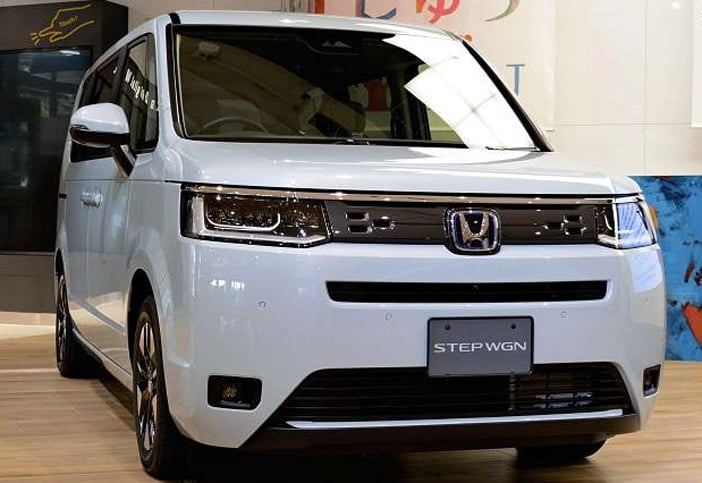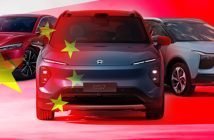+++ AIRLESS TIRES that never go flat or need to be inflated: It’s a decades-long dream that manufacturers hope to turn into a reality soon, but for truck drivers first. The challenges that the technology faces were put on display at a Goodyear test track in Luxembourg, where a group of journalists put a Tesla equipped with airless tires through its paces. Instead of being filled with air, the tires have a web of spokes that keep the wheels firm and give them a see-through look. The thin layer of rubber gripping the asphalt has a gargantuan physical challenge to meet: supporting the weight of the car and absorbing shocks as well as standard pneumatic tires for thousands and thousands of kilometers. That challenge is being overcome: the tyre’s rubber and plastic structure resisted the huge stress as the car banked into the track’s tight turns. The ride is smooth but the grip is not as good as on conventional tires, and they are noisier. The tires were tested for 120.000 kilometers at speeds of up to 160 kph in both scorching temperatures as well as snow, said Michael Rachita, who heads up Goodyear’s efforts to develop airless tires. “The most obvious advantage is that it’s puncture proof”, said Rachita. “It will never run flat, you could drive over any nail and expect not to lose performance”. Rachita said airless tires will also be maintenance free for drivers as they will never need to check and adjust air pressure. He said a second generation of airless tires that are lighter, quieter and roll better are in the works. Michelin has released the Tweel, but it is for construction vehicles rather than cars where the demands in terms of driving performance are much greater. The French firm has also unveiled the Uptis which it is developing with General Motors, and which it hopes can make the jump from auto shows to showrooms next year. Its researchers are working on a cocktail of fiberglass and resin to hold the rubber onto the honeycomb structure of the new tyre. But Michelin’s CEO Florent Menegaux doesn’t expect airless tyres to squeeze out regular tires anytime soon. “We’re going continue to have air tires for several decades”, he said. Goodyear, which submitted its first patent on airless tyre technology in 1982, has recently put its foot down on the accelerator in terms of research and development. The U.S. firm aims to have a maintenance-free and long-lasting airless tyre for cars by the end of the decade. It already has an early version for shuttle buses and automated delivery vehicles on university campuses. Bridgestone also hopes to have an airless tyre ready within a decade, having already tested early versions on utility vehicles. Other manufacturers are more skeptical that airless tires will ever offer comparable shock absorption as traditional tires and the noise can be reduced sufficiently. “They aren’t a viable solution and I don’t expect they will become one”, a Continental researcher, Gerrit Bolz, said at a tyre convention in 2017. But independent researcher Ulf Sandberg at the Swedish National Road and Transport Research Institute, which is working on an airless tyre for trucks, believes they will eventually become a viable alternative. “I believe that sooner or later airless tires could take over”, he told. “If rolling resistance is reduced by 50 percent, it would increase the range of vehicles by 25 percent, and could be extremely valuable for car manufacturers, particularly for electric vehicles where range is a key concern”. Airless tires could prove to be environmentally beneficial as they could last the entire lifetime of most vehicles and could then be recycled or retreaded for a second life. But manufacturers may not be burning rubber to bring airless tires to market because they also pose threats to their business model, said Sandberg. A switch to airless tires would strand the manufacturing equipment used for pneumatic tires, a heavy cost for the companies to bear. Given the longevity of the airless tires, companies would be making less of them. Goodyear’s vice president for product development in Europe, Xavier Fraipont, acknowledged that airless tires requires a “rethinking our business model, of rethinking our manufacturing”. Yet the possibility of gaining a lead on competitors or being left behind by an affordable and high-performing airless tyre for the consumer market keeps their research rolling forward. +++
+++ With more cities releasing policies on new energy vehicle BATTERY SWAPPING , the sector is expected to usher in a boom and better support the development of New Energy Vehicles (electric and plug-in hybrid cars). Earlier this month, Chongqing in Southwest China released their NEV battery swapping pilot plan, saying that the city will set up more than 200 battery-swap stations and promote more than 10.000 NEVs capable of battery swapping by 2023. The city is one of 11 selected by the Ministry of Industry and Information Technology to run a pilot program and speed up the construction of battery swapping infrastructure. In addition to the pilot cities, Dongguan in Guangdong province will establish 108.000 charging and swapping facilities by 2025, according to the city’s 14th 5-Year plan (2021-25) for NEV infrastructure released earlier this month. The electric vehicle action plan of Sichuan province, released in April, encourages cities to explore battery-swap modes and promote the operation of battery swapping in buses, taxis and logistics vehicles. Since 2020, China’s NEV sales have sustained rapid growth. Data from the China Association of Automobile Manufacturers showed that NEV sales in the January-April period totaled 1.56 million units, soaring by 110 percent from the same period of 2021. The CAAM has forecast that NEV sales will exceed 5 million units this year. With the thriving development of the NEV industry, the demand of supporting facilities has swollen. Battery swapping involves switching dead batteries for ones that are fully charged, rather than the more common method of recharging exhausted batteries at a charging station. Compared with traditional charging facilities, battery swapping takes a much shorter time and can help improve safety and lengthen battery life. It also has advantages in maintenance and management. With more government policies, the sector is expected to better support the development of NEVs, industry insiders said. Founder Securities forecast that there will be more than 3 million battery-swap cars with more than 28.000 supporting facilities by 2025. Top battery swapping companies also accelerated the layout of battery-swap stations nationwide. Statistics from the China Electric Vehicle Charging Infrastructure Promotion Alliance show that by April, there were 1.480 battery-swap stations across the country, of which 938 were from EV startup Nio and 434 from battery-swap company Aulton. Nio plans to set up more than 1.300 battery-swap stations by the end of this year and add 600 annually between 2022-25 in China, it said. Aulton plans to complete the construction of 10,000 battery swapping stations that could serve more than 10 million electric vehicles by 2025. The company’s battery swapping technology is currently compatible with nine models from seven mainstream automakers. And more companies have stepped into the market. Battery giant CATL has made an appearance on the battery-swap stage with new services dubbed EVOGO in January. According to CATL, the services will be rolled out first in 10 cities across China. Last month, CATL offered its first battery-swap services in Xiamen, Fujian province, and expects to open 30 battery-swap stations in the city by the end of this year. However, challenges remain when it comes to standardized battery design, high capital cost and low utilization rates. There isn’t a uniform standard for the battery models and packs of different car brands, and automakers have different battery technologies and standards that are not unified at present, which limits the practical application of battery swapping. Besides, battery-swap stations are expensive to build, operate and maintain. According to the new energy arm of BAIC Group, a battery swapping station will total nearly 10 million yuan ($1.49 million) in construction and 3.22 million yuan on battery reserves. +++
+++ Vehicle marques from CHINA are seeing rising popularity among local customers, primarily driven by their quick response to market demands and their leading position in the new energy vehicle segment. Last month, sales of sedans, SUVs and MPVs from Chinese carmakers totaled 551.000 units. Despite a 23.3 percent fall from the same month in 2021, which was the result of recent Covid-19 outbreaks, their market share moved up to 57 percent. That was 8.5 percentage points more from March and 14.9 percentage points more than April 2021, according to the China Association of Automobile Manufacturers. This may have something to do with the fact that they had seen fewer disruptions to production than major international brands including Volkswagen and Toyota, which have plants in hard-hit cities including Shanghai and Changchun. But Chinese marques had already seen a rise in their market share in the first 4 months of this year. They delivered 3.1 million units from January to April, accounting for 47.6 percent of the Chinese vehicle market, up 6 percentage points from the same period last year. The rising trend was more apparent in the SUV segment. Of the top 10 bestselling SUVs in April, 9 were from local Chinese brands ranging from BYD and Great Wall Motors to Geely and Chery. The only international brand model that made it into the top 10 list was the Wildlander from Toyota. Its sales stood at 8.274 units, ranking No 9, lagging far behind BYD’s Song Plus, whose deliveries reached 25.108 for the month. Edward Wang, managing director of syndicated research at J.D. Power China, said over the past few years, local Chinese brands are responding faster to market demands, as evidenced in terms of electric vehicles and smart functions. “Such innovation is injecting momentum into Chinese brands in a rapid, effective and continuous way”, said Wang. Wang made the remarks when J.D.Power released findings last week that showed 53 percent of the respondents said they would choose Chinese marques, and 67 percent of those who currently drive Chinese vehicles said they would choose Chinese brands again. The poll was conducted in March across 70 major cities in China, and the 11.340 respondents were those who would like to purchase vehicles in the next 6 months. The survey also found that those born after 1995 were more inclined to choose Chinese brands as they have more confidence and pride in their country. In terms of vehicles, they give top priority to smart functions and beautiful designs. Of the major elements that affect their vehicle purchase decision, the top one was “whether the car is goodlooking”, said J.D.Power. Also, the popularity of NEVs is helping expand the share of local Chinese brands. A total of 312.000 NEVs were produced and 299.000 were sold in April, up 43.9 percent and 44.6 percent year-on-year, respectively, although the overall market went down more than 46 percent from the same month last year, according to the China Association of Automobile Manufacturers. Currently, the absolute majority of NEV models available in the market are from Chinese carmakers, as international volume brands including Volkswagen and Toyota have just started to make inroads into the booming segment. Chinese NEV maker BYD sold 105.475 units in April, up 136.5 percent year-on-year. It was the only carmaker to see growth in the Chinese market last month. The J.D. Power survey showed 27 percent of the respondents said they would like to choose an NEV this year. The figure is even higher, at 33.6 percent, when it comes to the general acceptance of such vehicles. In comparison, the figure was 19.6 percent in the United States, said J.D.Power. China will start a campaign in June to promote NEV sales in the country’s smaller cities and vast countryside. Experts have called for government measures to help boost the vehicle market that was crippled over the past months. The CAAM said the sector will reach the 5 percent growth goal, with NEVs as a driving force. The association expects this year’s NEV sales to reach 5 million, up from 3.5 million in 2021, despite headwinds including chip shortages and disruptions caused by Covid-19 to vehicle production. +++
+++ If global automakers think they can extend their dominance in CHINA into the electric era, they may be in for a shock. Kings of the combustion age such as General Motors and Volkswagen are falling behind local players in the booming electric vehicle market in China, a country that’s key to funding and developing their electric and autonomous ambitions. For Beijing office worker Tianna Cheng, the main dilemma when she was buying a 180.000 yuan ($27.000) Xpeng electric crossover was whether she should go for a BYD car instead or a Nio; she did not seriously consider overseas marques. “If I was buying a gasoline car, I may have considered foreign brands”, the 29-year-old said as she drove home from work. “But I wanted an EV, and other than Tesla, I saw few foreign brands applying advanced smart technology properly”. Buoyed by demand from consumers like Cheng, electric car sales are rocketing in China’s roughly $500 billion auto market, the world’s biggest. In the first 4 months of 2022, the number of New Energy Vehicles (pure EVs and plug-in hybrids) more than doubled from a year earlier to 1.49 million cars, according to data from the China Association of Automobile Manufacturers. The cleaner technologies accounted for 23% of China’s passenger car market, where overall vehicle sales fell 12%, reflecting a steep decline in demand for gasoline cars. There are no foreign brands among the top 10 automakers in the new energy vehicle (NEV) segment this year, with the notable exception of U.S. electric pioneer Tesla in third place, according to China Passenger Car Association data. All the rest are Chinese brands, from BYD and Wuling to Chery and Xpeng. China leader BYD has sold about 390.000 EVs in the country this year, more than 3 times as many as global leader Tesla sold there. The top-ranked traditional carmaker is Volkswagen’s venture with FAW Group, in 15th place for EV sales. Cheng said that overseas marques, whether the Buick Velite 7 or Volkswagen’s ID. series, failed to provide what she was looking for: an EV capable of giving her the “comfort” of having a smartphone-like experience in her vehicle. “Foreign brands are so far from my life and lifestyle”, said Cheng, whose digital assistant handles connections to apps like Alipay and Taobao and “does everything for me from opening the windows to turning on music”, while her car software provides over-the-air updates. It’s quite a reversal. Global brands have dominated in China since the 1990s, typically winning a collective 60% to 70% share of passenger car sales in recent years. In the first 4 months of 2022 they captured 52%, with their April monthly share at 43%. Signalling the scale of the challenge facing traditional automakers, Nissan CEO Makoto Uchida said that some brands “could disappear in 3 to 5 years” in China. “Local brands are becoming stronger”, said Uchida, who was formerly Nissan’s China chief, adding that the quality of EVs from Chinese makers had improved rapidly, with advances being made in the space of months. “There will be a lot of transformation in China and we need to carefully watch the situation”, said the CEO, adding that carmakers had to be nimble in the design, development and launch of new models. “In those aspects, if we were slow, we would be left behind”. Bill Russo, a former Chrysler executive who now heads Shanghai-based consultancy Automobility, said global brands need to turn the situation around quickly because they controlled less than 20% of China’s only growth auto market. “Chinese brands are wining the race to EV”, said Russo, adding that consumers’ shift to cars that are essentially smartphones on 4 wheels appeared irreversible and that traditional carmakers are having trouble keeping up. “I think it’s a secular shift toward high tech”, he said of the consumer demand for a “user-centric digital services experience” with a focus on interface, connectivity and apps. “Traditional companies are not high-tech natives”. Volkswagen Group brands, including Volkswagen, Audi, Bentley, Lamborghini, Porsche and Skoda, have led the market for much of the past 2 decades, alongside General Motors marques such as Buick, Chevrolet and Cadillac. The 2 global groups had overall auto market shares of almost 13% and 12% respectively in China last year, according to LMC Automotive. Detroit giant GM also has a 44% stake in the locally controlled SAIC-GM-Wuling Auto (SGMW) venture, and includes its sales in group numbers, though SGMW does not make American brands, only Wuling and Baojun cars. GM is now focused on winning over younger buyers in big cities that have hitherto largely snubbed its models, according to 2 people familiar with the automaker’s business in China. The group has announced electrification plans to spend more than $35 billion globally by 2025, including more than 30 new EVs, over 20 of them in China, starting this year with the launch of the all-electric Cadillac Lyriq. The 2 sources said the Lyriq launch would be followed by an electric Buick and a smaller, sportier electric crossover, both also planned for as early as this year. Sales of Buicks declined 32% over the last five years to 828.600 vehicles in 2021, while Chevrolet shrunk by more than half to 269.000 vehicles, according to LMC Automotive. GM said it was aiming to install capacity to produce 1 million EVs a year by 2025 in China, adding that demand for the Buick Velite NEV family and Chevrolet Menlo EV “both grew significantly” in 2021 and the first 3 months of this year. It said it was deploying smart technologies including hands-free driver assistance on highways, “aviation-grade” cybersecurity and over-the-air software updates. Volkswagen, which plans to spend around $55 billion globally on EVs by 2026, launched its ID. series in China early last year but missed its goal of selling 80.000 to 100.000 cars in 2021. It aims to sell 160.000 to 200.000 ID. cars this year, though it has sold only 33.300 through April. A key concern for foreign brands, according to one of the people close to GM plus a Volkswagen insider, is that their new EVs are being designed more with American and European markets in mind, with a heavier focus on performance and durability. “Autobahn speeds? In most big cities in China, traffic is so congested people can’t even drive above 60 kph on most days”, said the source close to GM, who is familiar with the automaker’s product plans and product-development processes. Volkswagen said NEV demand in China was strongly linked to the “smart car” theme, adding that it was investing in local research and development, especially in software. “Our strategy will enable us to achieve our ambitious targets in China. By 2030, we also want to be the market leader in e-vehicles and thus ensure that Volkswagen remains the No. 1 in China in the future”, it added. The challenge for global brands is to find the formula to win over consumers in big cities with disposable incomes, like Cheng in Beijing and Li Huayuan, a civil engineer from Shanghai. Li only half-heartedly considered Japanese and German brands when he bought his BYD electric sedan last year for 290.000 yuan including insurance. “Seems to me only Tesla stands out when it comes to American brands”, he said from his parked BYD car in the Sichuan provincial city of Mianyang, where he’s working on a project. “The other brands don’t even look competitive to me”. +++
+++ Posco Chemical said Friday it has signed a deal to create a joint venture with GENERAL MOTORS to launch a cathode materials plant in Quebec, Canada. Posco Chemical will invest 351.2 billion won ($278 million) in the joint venture, called Ultium CAM, to build a high-nickel cathode materials plant in Becancour. The total investment will be $327 million. The factory will have a 30.000 ton annual capacity, which is enough to supply around 220.000 electric vehicles (EVs). Cathodes are 1 of 4 core materials in lithium-ion batteries, which power electric vehicles. Made of lithium, nickel, cobalt and manganese, cathode materials account for 40 percent of the production cost of an EV battery. Construction of the plant is scheduled to begin in August and is expected to be completed by the second half of 2024. The cathode materials that are produced will be sold to Ultium Cells, a 50:50 joint venture between General Motors and Korean battery maker LG Energy Solution that makes batteries for the U.S. automaker’s EVs. Posco Chemical’s relationship with Ultium Cells started in 2020, when it was chosen as cathode materials supplier. Posco Chemical was also chosen as Ultium Cells’ anode materials supplier, another key component of an EV battery. Posco Chemical has invested 600 billion won in its Gwangyang cathode materials factory to ramp up output from 40.000 tons to 60.000 tons per year. Construction is expected to finish in July. Last year, the company announced an investment of 281 billion won to build a cathode materials plant in China with an annual manufacturing capacity of 30,000 tons with local partner Huayou Cobalt. Posco Chemical aims to increase its annual production capacity for cathode materials from 105.000 tons per year in 2022 to 345.000 tons per year in 2025 and 610.000 tons in 2030. The anode production capacity will increase to 170.000 tons in 2025 and 320.000 tons in 2030, it said. “Based on close cooperation between the 2 companies, we intend to produce quality battery materials to raise the competitiveness”, said Min Kyung-zoon, CEO of Posco Chemical. +++
+++ HONDA on Friday launched 2 new models in its Step WGN line, its first fully revamped MPV in about 7 years. Honda said the new models have been made more spacious and comfortable, with the largest interior capacity ever for a Honda vehicle sold in the nation. The prices including tax range from about ¥2.99 million to about ¥3.84 million. The 2 new models available are the Step WGN Air, with a simple exterior design, and the Step WGN Spada, with a stately design. Both Air and Spada models are available as hybrid and gasoline versions. Due to a shortage of semiconductors and other factors, delivery of the hybrid model is expected to take approximately 5 months, while the gasoline model can be delivered in about 4 months. The automaker expects to sell 5.000 units per month. +++

+++ HYUNDAI and affiliate Kia claimed the third-biggest market share in Europe in the first quarter this year. According to the Korea Automobile Manufacturers Association, Hyundai and Kia sold a combined 270.000 vehicles in Europe in the January-March period, an on-year increase of more than 21 percent. Their market share was 9.8 percent. Despite chip shortages and soaring oil prices, they claimed the third-largest market share due to strong demand for eco-friendly vehicles. Volkswagen led the market with 23.8 percent, followed by Stellantis with 19 percent. Hyundai and Kia also ranked third in the United States in the first quarter with sales of 320.000 cars, thanks to increased demand for electric cars. However, their sales in China plummeted by 39.3 percent to 94,000 cars. +++
+++ China’s PICK-UP TRUCK sales dropped 11 percent year-on-year in the first 4 months of the year due to Covid-19 disruptions to production, industry data showed. A total of 165.000 pickup trucks were sold during the period, according to the China Passenger Car Association. In geographical breakdown, more than 40 percent of the consumer demand for pickup trucks comes from the country’s northwestern and southwestern regions. At present, small and medium-sized cities as well as counties and towns are among the major markets for pickup truck sales, said the association. The association remains bullish on the future performance of the pickup truck market, highlighting policy incentives for improving product quality and removing travel restrictions to boost consumption. It projected continuous rapid growth of pickup truck consumption in the long term in China. +++
+++ PORSCHE has acknowledged that it failed to “take into full consideration Chinese customers’ voices”, adding that it values Chinese customers and will better integrate into the local market. Porsche China’s chief operating officer David Xiao made the remarks in an exclusive interview last week with China Daily amid monthslong protests from Chinese customers who claimed the German carmaker had eaten its words about a steering function. In the first half of 2021, Porsche found that it could not get enough chips for electrically adjustable steering columns. It decided in July that year to deliver the vehicles first and promised to enable the function when the chips became available. However, some Chinese customers were told when they received their vehicles this year that Porsche would not enable the function. Instead, it would offer a 2.300 yuan ($346) aftersales voucher. Up to 20.000 Porsche vehicles sold in the Chinese market are affected, involving almost all models available in the country, which is Porsche’s largest market worldwide. Meanwhile, in the US Porsche emailed owners of affected vehicles and offered $500 in compensation. Chinese customers felt this rubbed salt into their injury, calling Porsche’s approach in different countries “unfair and a snub”. Some claim that Porsche did not show respect to its Chinese customers and may have broken the law as the electric function was part of the vehicle purchase contract. In a statement last week, Porsche China vowed to make the steering column in all its vehicles electronically adjustable, a default configuration it had originally decided in March to cancel without customers’ consent. Porsche China said it is now possible to install the function after it held negotiations with its headquarters in Stuttgart, Germany. The works will start in the third quarter of this year. The China unit added that the works will run for some time because of the ongoing chip shortages that have been hurting the global auto industry since late 2020. Those customers who would not like to restore the function will get a fixed amount of financial compensation. That figure will be 13.800 yuan, according to Porsche dealers. Porsche China said the original 2.300 yuan plan was the decision of Stuttgart for the global market. “We now realize that we failed to take full consideration of Chinese customers’ voices and did not do sufficient work in our dialogues with them. We would like to apologize for that”, said Xiao, who is also Porsche China’s vice-president in charge of sales and marketing. Xiao said the incident is “an important lesson” for Porsche and they would step up efforts to improve customer satisfaction. Analysts said the fumbled handling of the situation harmed Porsche’s reputation in China, where sales reached almost 96.000 units in 2021, accounting for almost one-third of its global deliveries that year. Xiao said it values the Chinese market and its consumers because of the market potential and the country’s role in the global auto industry. “We will listen to Chinese customers more carefully to better integrate into the Chinese market”, said Xiao. +++
+++ Samsung SDI will join hands with global auto giant STELLANTIS to build a battery plant for electric vehicles in Kokomo, Indiana. The Korean company will invest US$2.5 billion or more than half of the total cost. Stellantis is a behemoth created by the recent merger of Fiat Chrysler Automobiles and Peugeot SA, combining such brands as Citroën, Maserati, Opel and Peugeot. The 2 companies and the Indiana state government held a press junket in Kokomo announcing the project on Tuesday. Production will begin in the first quarter of 2025 with initial output of 23 GWh in EV batteries a year and expanding to 33 GWh later. Kokomo is already home to an auto parts factory owned by Stellantis, so when the plant is built, Indiana will become a North American hub of EV production. The plant will use Samsung SDI’s cutting-edge PRiMX battery technology that was unveiled at the Consumer Electronics Show in Las Vegas in January this year. +++
+++ TOYOTA on Friday cut its global production plan for June for the second time this week and signaled its full-year output estimate could be lowered, highlighting the pain from the supply chain crunch and lockdowns in China. Global automakers’ production has been hit by the microchip shortage and also by China’s Covid-19 lockdowns. The reduction by Toyota (broadly seen as a bellwether for Japan Inc.) comes a day after data showed car sales in China, Europe and the United States remain weak. Japan’s largest automaker said it now expected to produce around 50.000 fewer vehicles in June, for a total of around 800.000, due to the lockdown in Shanghai. It had already cut its plan for the same month by 100.000 vehicles on Tuesday, citing the chip shortage. Toyota said there was “a possibility” that it could lower its full-year production plan of 9.7 million vehicles. “It is very difficult to estimate the current supply situation of parts due to the ongoing lockdown in Shanghai”, it said. That lack of certainty on parts has been a constant refrain for automakers, in both Japan and elsewhere. Given that China is both the world’s largest auto market and a global manufacturing giant, the lockdowns there have implications for both supply and demand, analysts have said. This month, Subaru warned that its U.S. dealers have a record low stockpile of around 5.000 vehicles left, while Honda said it would slash production by 20% at 2 domestic factories. Toyota said that its Corolla, RAV4, Prius and 4Runner models would be among those impacted by the production suspension. +++



